Jacob McMurray is MoPOP's Director of Curatorial, Collections & Exhibits.
MoPOP Picks: Our 10 Favorite Jimi Hendrix Artifacts
MoPOP has the largest collection of Jimi Hendrix artifacts in the world. At nearly 6,000 objects, that’s a lot!
I joined the team in 1994 during the early planning phases for the museum, which means I was lucky enough to be here while we were collecting many of the amazing pieces in our Hendrix collection.
People often forget that everything in our museum started with Jimi Hendrix. Our founder, Paul G. Allen, was enamored with the guitarist from the first time he heard Hendrix’s 1967 debut album Are You Experienced? and wanted to create a museum dedicated to him.
There are so many cool objects related to Hendrix in our collection, each one a testament to his multi-faceted talents and endless curiosity. It’s hard to narrow down my favs, but here are ten that I absolutely love!

1. Handwritten lyrics for “Love or Confusion”
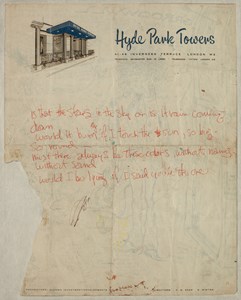

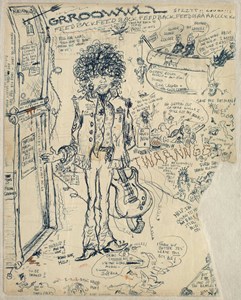
Jimi Hendrix wrote this early version of the lyrics for his song “Love or Confusion” in late 1966 in now-faded red ink on one side of a sheet of Hyde Park Towers hotel stationary. He and his girlfriend Kathy Etchingham lived in the hotel from soon after he arrived in London on September 24, 1966 until December 6, 1966. These lyrics evolved into the final version of “Love or Confusion,” which was recorded at De Lane Lea Studios on November 24, 1966 and released on the Jimi Hendrix Experience’s debut album, Are You Experienced? on May 12, 1967.
According to Kathy Etchingham, the cartoon on the reverse side of the lyric sheet was primarily illustrated by Hendrix, while she advised on what to include and added elements of her own. Based on the content, it is likely the cartoon was completed early to mid-1967, several months after Hendrix had penned the lyrics on the opposite side. It features several details that defined Hendrix at the time, including his Bob Dylan-esque hair, military jacket, Iron Cross necklace, heeled boots, and Marshall amplifier stack. It emphasizes Hendrix’s rising status in the London Scene, making comic reference to managers Chas Chandler and Mike Jeffery, road manager Gerry Stickells, and musicians Eric Clapton, Jeff Beck, Zoot Money, the Small Faces, the Who, and the Beatles.
2. Signed contract for “Stone Free”
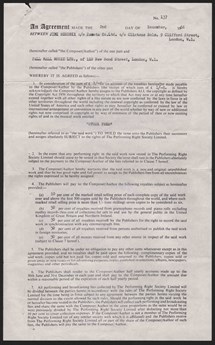
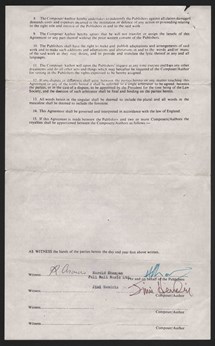
On October 23, 1966, a week after the Experience had returned from their short French tour with Johnny Hallyday, the Jimi Hendrix Experience went to De Lane Lea Studios in London and recorded their first song, “Hey Joe.” Manager Chas Chandler and Jimi Hendrix knew that “Hey Joe” would be the A side of the Experience’s first single, but there was a little debate about the B side.
Hendrix was intent on recording a cover version of Wilson Picket’s huge hit, “Land of a Thousand Dances,” but Chandler argued for Hendrix to write and record his own song, to establish the guitarist as an original songwriter, and to maximize the profits if the song was a success. “Stone Free,” a blues-inflected, upbeat rocker, was the result — Hendrix’s first original composition with the Experience. Released on December 16, 1966, the single marked the start of an enduring fascination for many Londoners with the Jimi Hendrix Experience.
3. Octavia Prototype Effects Pedal
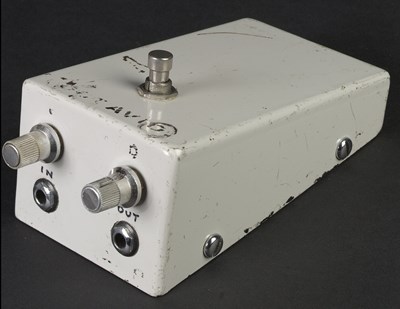
This Octavia prototype (written here as “Octavio”) was created by British electrical engineer Roger Mayer (b. 1946) for guitarist Jimi Hendrix. The Octavia added a distorted harmonic to Hendrix’s guitar, recognizably on his songs “Purple Haze” and “Fire”.
When a guitar is played loud enough through a powerful amplifier, the interaction can create a continuous sound loop. This “feedback” has been a challenge since the dawn of amplification, but over time guitarists such as Jimi Hendrix learned to control it. On January 11, 1967, Hendrix met Roger Mayer, who had been building early distortion pedals, or “fuzz boxes,” for guitarists such as Jimmy Page, Big Jim Sullivan, and Jeff Beck. Knowing that feedback often produces a note an octave higher than the note actually played, Mayer designed a fuzz box for Hendrix, called the Octavia, that not only produced a heavily distorted sound, but also contained a filter that emphasized this octave harmonic.
This new pedal was first heard on the solo for Hendrix’s early hit, “Purple Haze,” and throughout “Fire,” both recorded in February 1967. Mayer continued to experiment with the Octavia circuit, rapidly iterating and producing over a dozen for Hendrix from 1967-1969. The Octavia prototype here features a wedge-shaped enclosure which did not appear until April 1968.
4. Handbill for the Walker Brothers tour
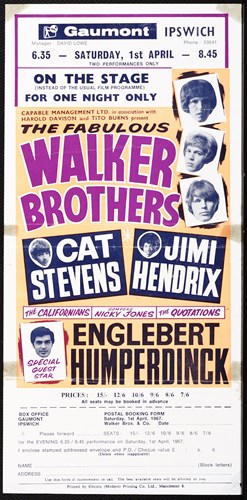
This tour was Hendrix’s first high-profile tour since moving to the United Kingdom in September 1966.
The Walker Brothers were a pop group from Los Angeles that had several Top 10 UK hits and were the teenage pop fan’s dream. On March 31st, they launched a month-long farewell tour, along with Cat Stevens, Englebert Humperdinck, and others – groups that didn’t really match Hendrix and his bombastic Experience.
To illustrate the sonic mismatch, Hendrix was quoted in Disc and Music Echo on April 1, 1967: “‘I can just hardly wait,’ says the cool Mr. Hendrix about a tour on which he and his wild Experience will fit in about as well as a trio of San Francisco hippies at a vicarage tea-party.”
Although the Jimi Hendrix Experience had released two successful singles, “Hey Joe” and “Purple Haze” by the time of this show, they continued the tour as the opening act. This arrangement did not sit well with Hendrix’s fellow artists because any performer who followed his short but intense set often had to endure the audience chanting “Jimi! Jimi!” in hopes that Hendrix would return to the stage. At the Finsbury Park Astoria the night before the Gaumont show, Hendrix shocked Walkers’ fans by grinding into his amplifiers and lighting his guitar on fire. The music tabloids had a field day with Hendrix’s stage antics, which only added to the guitarist’s growing allure.
5. Fender Stratocaster smashed at Saville Theatre
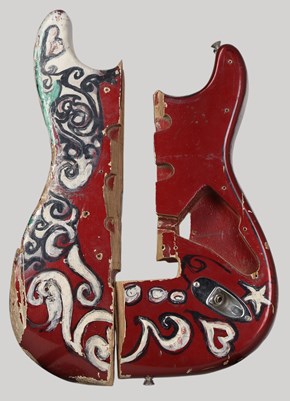
Jimi Hendrix smashed this painted Fender Stratocaster guitar on June 4, 1967, to commemorate his final show in London, before leaving England to play at the Monterey Pop Festival two weeks later. On the back of the guitar he painted a poem that incorporates the lyrics to his song “Love or Confusion,” along with an allusion to his guitar as a loving sacrifice.
He started off the legendary evening set with a rendition of “Sgt. Pepper’s Lonely Hearts Club Band,” to acknowledge the Beatles’ album debuting at No. 1 a week earlier. For the last song, “Are You Experienced?,” Hendrix took this guitar from backstage that he had painted that day and at the end of the song smashed it. The two pieces on display here are all that remain: an instrument, an art piece, a sacrifice.
According to Hugh Nolan, writing in the June 10, 1967 issue of Disc and Music Echo, “Then, to a smashing, ear-splitting “Are You Experienced?” Jimi was handed a guitar from the wings—a guitar he’d painted in glorious swirling colours and written a poem on the back dedicated to Britain and its audiences—and, bathed in a flickering strobe light, crashed the guitar about the stage and hurled what was left of it to eager souvenir-hunters in the audience.”
6. Original cover art for US version of 'Are You Experienced?'
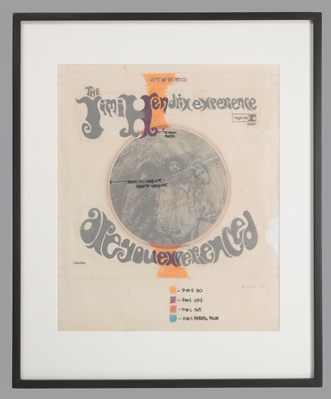
The Jimi Hendrix Experience’s debut album, Are You Experienced? was released in the UK on May 12, 1967, on Track Records. The US version was released on Reprise Records on August 23, 1967. This original cover art with a color key overlay for the US version was designed by British photographer and designer Karl Ferris (b. 1948).
Throughout 1967, between constant club gigs, tours, press interviews, and television appearances, Jimi Hendrix recorded songs for his debut album, Are You Experienced? It was released one week after the debut of the band’s third single, “The Wind Cries Mary.” The album soon shot up to #2 on the charts, behind the Beatles’ Sgt. Pepper’s Lonely Hearts Club Band.
While the album launched in the UK and Europe in March of 1967, the Experience’s explosive US concert debut at the Monterey International Pop Festival in June convinced Reprise to release the record in North America, albeit with some track changes. The label requested the addition of the band’s early single hits: “Hey Joe,” “Purple Haze,” and “The Wind Cries Mary,” but omitted “Red House,” “Can You See Me,” and “Remember,” because Reprise felt US audiences weren’t as receptive to blues songs.
For many fans who weren’t able to see Hendrix live, the album was a revelation. The Jimi Hendrix Experience in concert was about dynamic showmanship, raw instrumentation, and pure volume. For Are You Experienced?, the recording studio became not only a method of documentation, but a powerful tool in composition. With it, Hendrix created a new paradigm in psychedelic sound.
7. Photograph of Jimi Hendrix and his sister Janie backstage at the Seattle Center Arena
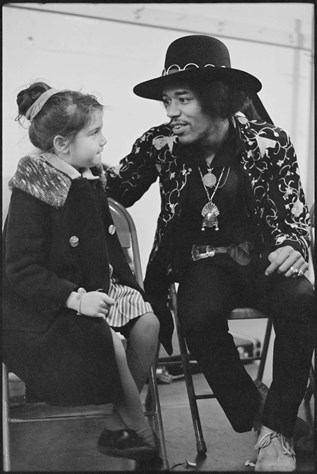
In 1961 Hendrix left Seattle, the city where he grew up, to join the Army. Over the next several years, he traveled extensively, played guitar around the US with some of the biggest rhythm-and-blues stars of the era, then moved to the UK where he quickly rose in prominence in the London music scene. By early 1968, he was a bona fide superstar, touring the US with his group, the Jimi Hendrix Experience.
On February 12, 1968, Jimi Hendrix returned to his hometown of Seattle for the first time in seven years. He was greeted by his father Al and brother Leon and was introduced to his new stepmother Ayako “June” Fujita Hendrix. That evening, Hendrix answered questions from reporters and posed for photos, including this one, taken by Ulvis Alberts, with his new sister Janie, backstage at the Seattle Center Arena (now the site of Marion Oliver McCaw Hall).
Despite being arranged one week prior, Hendrix’s concert sold out, a testament to the guitarist’s popularity and hometown appeal. Journalist Patrick MacDonald of the Seattle Post-Intelligencer wrote of the performance: “A Seattle boy who left this city some seven years ago … returned last night to a truly triumphant homecoming.” The next morning, Hendrix attended a short assembly at his former school, Garfield High School, before flying to Los Angeles. His Seattle homecoming lasted less than 24 hours.
8. Jimi Hendrix’s personal diary

Jimi Hendrix penned his first entry in this diary on March 19, 1968, when he recounts a meeting with musician Joni Mitchell in Ottawa, Canada and mentions how struck he was by her “heaven words.” Over the next 12 entries, Hendrix comments on his concert performances, buying new gear, meeting old friends and new, and the changing American social fabric. He wrote his last entry on August 7, the day the Experience sat for a photo shoot with Linda Eastman, who later married Paul McCartney of the Beatles. Hendrix says of Eastman: “She loves me. She is beautiful. She loves me. Tomorrow she will be gone again but she never gets away.”
9. Vinyl LP box set of Handel’s Messiah
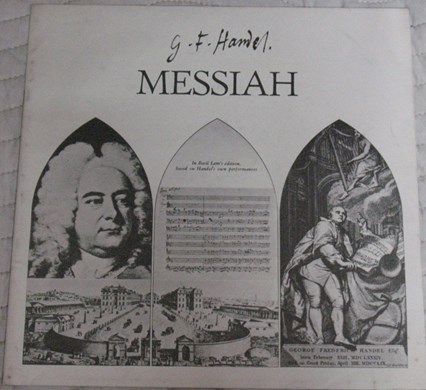
This 1967 vinyl record box set of George Frideric Handel’s Messiah, conducted by Charles Makerras (b. 1925) with the English Chamber Orchestra, is one of 139 records once owned by Jimi Hendrix and now part of MoPOP’s permanent collection. Hendrix’s musical tastes were diverse, and his record collection showcases a diverse selection of musical genres, including rock, folk, classical, jazz, R&B, country, blues, and Indian classical music.
In July 1968, Jimi Hendrix moved to 23 Brook Street in London. The flat was next door to the house where composer George Frideric Handel lived nearly 230 years prior. According to Kathy Etchingham, Hendrix’s girlfriend at the time, when Jimi found out that Handel had lived there, he went out to a local record shop and bought a copy of Messiah, possibly this one.
10. Fender Stratocaster played by Jimi Hendrix at Woodstock
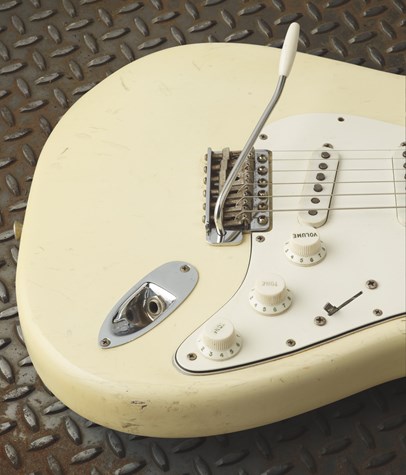
Jimi Hendrix played this 1968 Olympic White Fender Stratocaster electric guitar most famously at the Woodstock Music and Arts Fair in Bethel, New York on August 18, 1969.
While Hendrix owned many Stratocasters in his lifetime; this Strat seemed to be a favorite. He purchased it new at Manny's Music in New York City, most likely in the fall of 1968, and played it at several shows between October 1968 through September 1970. The guitar has survived relatively unscathed given Hendrix’s aggressive playing style, but upon close inspection there are many indications of use, including small indentations along the body, which could be from Hendrix’s rings as he played. There is also worn finish on the headstock near where the strings attach, where Hendrix may have wedged a cigarette during performances.
As he was left-handed and left-handed guitars were hard to find at the time, some modifications needed to be made to this right-handed guitar, including reversing the strings and the bone nut near the headstock, switching the position of the strap pin from the longer horn to the shorter horn, and then playing the guitar upside-down.
The 1969 Woodstock Music & Art Fair was one of the decade’s defining cultural events, and Jimi Hendrix’s extraordinary, unprecedented rendering of “The Star-Spangled Banner” was a defining moment of the festival. With this guitar, Hendrix evoked the majesty of America while also summoning the howling undercurrents of dissonance and violence echoing the Vietnam War and the nation's deep racial struggles.
Shortly before his death on September 18, 1970, Hendrix gave this guitar to Mitch Mitchell (1946-2008), the drummer for the Jimi Hendrix Experience.
Need something to look forward to? Plan your next visit! Hope to see you at Jimi Hendrix's 80th birthday celebration!